Fresh herbs don’t have to come from the store – you can grow them right inside your home with just a bit of planning.
An indoor herb garden makes it easy to snip what you need while cooking, without stepping outside.
But to grow healthy, productive herbs indoors, you need more than just a sunny window and a watering can.
In this article, I'll take you through every part of the process – from choosing the right containers and soil to planting, watering, harvesting, and even troubleshooting.
Whether you're growing basil on your kitchen counter or rosemary by the window, you'll learn how to set up a herb garden that actually works.
Why Grow Herbs Indoors?
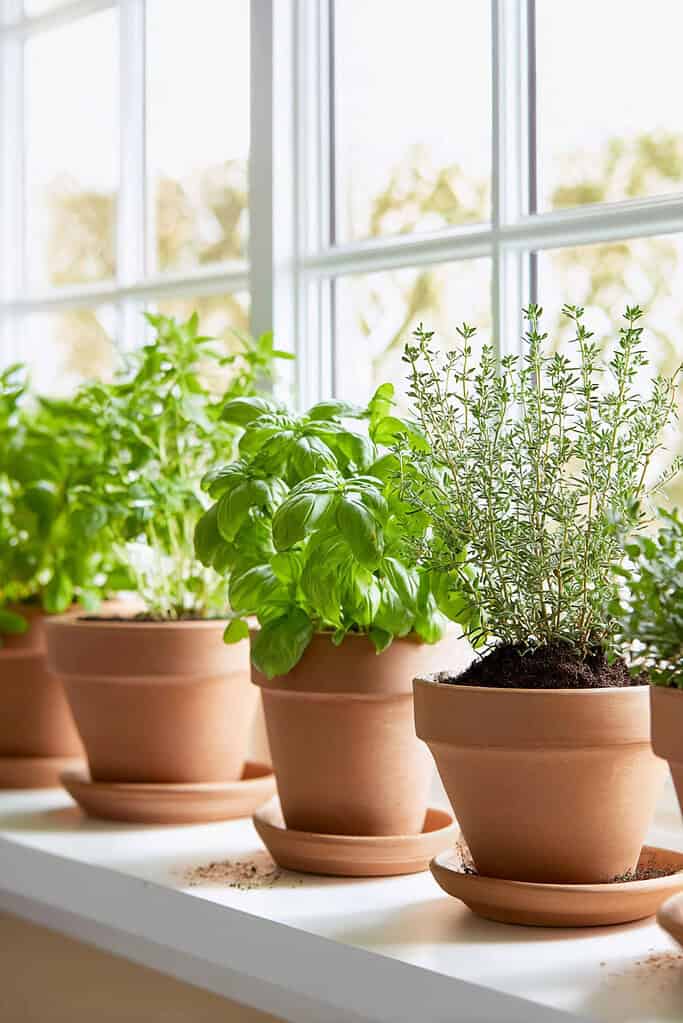
An indoor herb garden offers more than convenience – it gives you control, freshness, and year-round access to ingredients that are often overpriced or wilted by the time you buy them.
Growing herbs indoors also saves space and fits well into small apartments, homes with limited outdoor areas, or places with short growing seasons.
You don’t need a backyard or a greenhouse. A sunny windowsill or a grow light is enough to grow many herbs successfully. With proper setup, indoor herbs often stay cleaner, face fewer pests, and require less weeding than outdoor gardens.
In addition to saving money over time, growing herbs indoors lets you pick exactly what you need, when you need it. This avoids waste and ensures maximum flavor.
You can also grow herbs that are harder to find fresh in stores or customize your plant selection based on how often you use them in cooking.
Ready to get started? Learn more about how to start a herb garden and bring fresh, flavorful herbs into your home all year long.
Choosing the Right Location Inside Your Home

The location of your indoor herb garden has a direct impact on how well your herbs grow.
Light, temperature, airflow, and humidity all play a role in keeping herbs healthy and productive. Here’s how to create the right environment inside your home.
Provide at Least 6 Hours of Sunlight Daily
Most herbs need a minimum of 6 hours of direct sunlight per day.
South-facing windows are ideal because they receive the most light. East- and west-facing windows may work for herbs that tolerate less light, like parsley or mint.
If your windows don’t get enough sun, especially in winter or cloudy climates, your herbs may struggle. That’s when artificial light becomes necessary.
Use Grow Lights for Low-Light Spaces
If sunlight is limited, use full-spectrum LED or fluorescent grow lights designed for herbs and vegetables.
These lights should be placed about 6 to 12 inches above the plants and kept on for 12–14 hours a day.
Grow lights are especially useful in darker rooms or during seasons with shorter daylight hours.
Looking for an easy setup? Check out the best indoor herb garden kits for herbs to get started quickly and effortlessly.
Keep Herbs in a Stable Temperature Range
Herbs grow best in rooms with temperatures between 65–75°F (18–24°C). Avoid placing them near:
- Drafty windows or doors
- Heaters, radiators, or vents
- Appliances that give off heat
Sudden temperature changes can cause stress and stunt growth.
Maintain Air Circulation to Prevent Problems
Good air movement helps prevent mold, mildew, and some pest issues.
Use a ceiling fan on a low setting or open a nearby window occasionally to let fresh air in. Just avoid placing herbs directly in a strong draft.
Watch Indoor Humidity, Especially in Winter
Dry air from heating systems can make herbs like basil and parsley wilt or curl at the edges. If this happens:
- Place a shallow bowl of water near your herb pots
- Group plants together to increase localized humidity
- Use a small humidifier if the air is very dry
Best Herbs to Grow Indoors
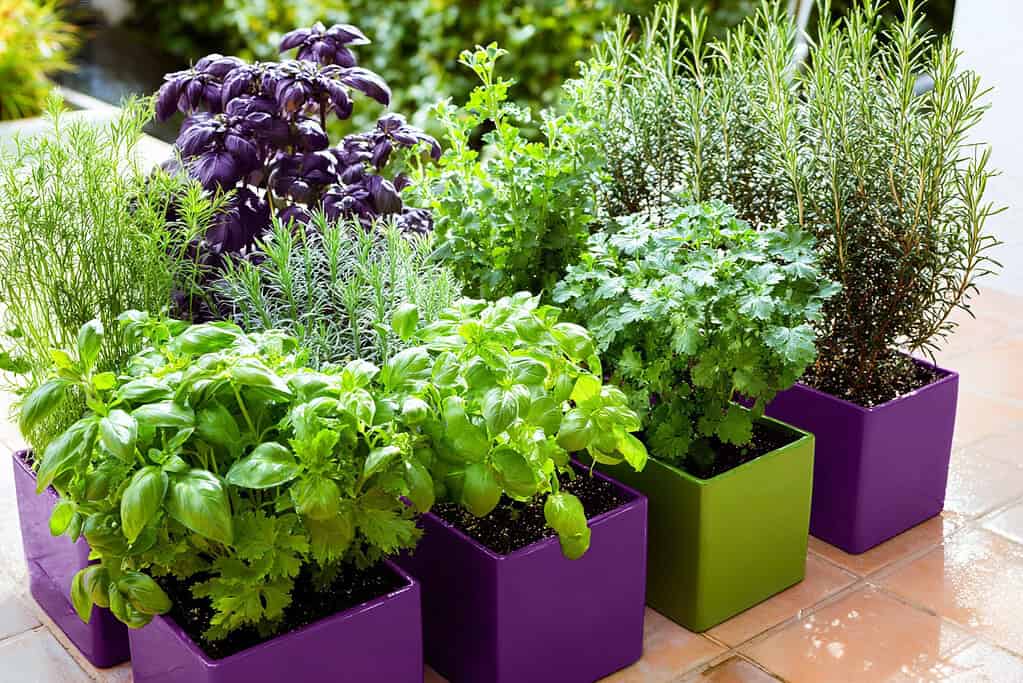
Some herbs adapt well to indoor conditions and grow with minimal effort, while others may struggle without careful care.
Here are the top herbs to grow indoors, along with tips on their growing needs.
Easy Herbs for Beginners
These herbs grow well in pots, handle indoor conditions with ease, and provide steady harvests:
- Basil – Thrives in warm conditions with plenty of sunlight. Keep the soil evenly moist and pinch regularly to encourage bushy growth.
- Parsley – Grows slowly at first but becomes productive with good light. Prefers moist, well-drained soil.
- Chives – Very low-maintenance. Tolerates partial light and benefits from regular trimming.
- Oregano – Hardy and drought-tolerant. Prefers fast-draining soil and needs less frequent watering.
- Thyme – Compact and easy to manage indoors. Needs strong light and free-draining soil.
- Mint – Fast grower that tolerates lower light levels. Must be planted alone to avoid taking over other herbs.
- Cilantro – Grows fast but is short-lived. Needs cooler temperatures and regular replanting for a steady supply.
Herbs That Need Extra Attention
These herbs can still grow well indoors, but they have specific needs that require closer monitoring:
- Rosemary – Prefers bright light and fast-draining soil. Sensitive to overwatering, especially in cooler homes.
- Sage – Needs full sunlight and well-draining soil. Avoid heavy watering.
- Bay Laurel – Slow-growing but long-lived. Likes bright light and airflow. Watch for pests like scale insects.
Short-Term vs Long-Term Indoor Herbs
Some herbs grow for months with proper care, while others need to be replanted regularly:
- Short-term herbs: Basil, cilantro, and chervil often become woody or bolt within weeks. To keep a continuous supply, start a new batch from seed every few weeks.
- Long-term herbs: Rosemary, thyme, chives, oregano, and mint can live and produce for many months or even years indoors if kept healthy.
Choosing the Right Containers for Indoor Herbs
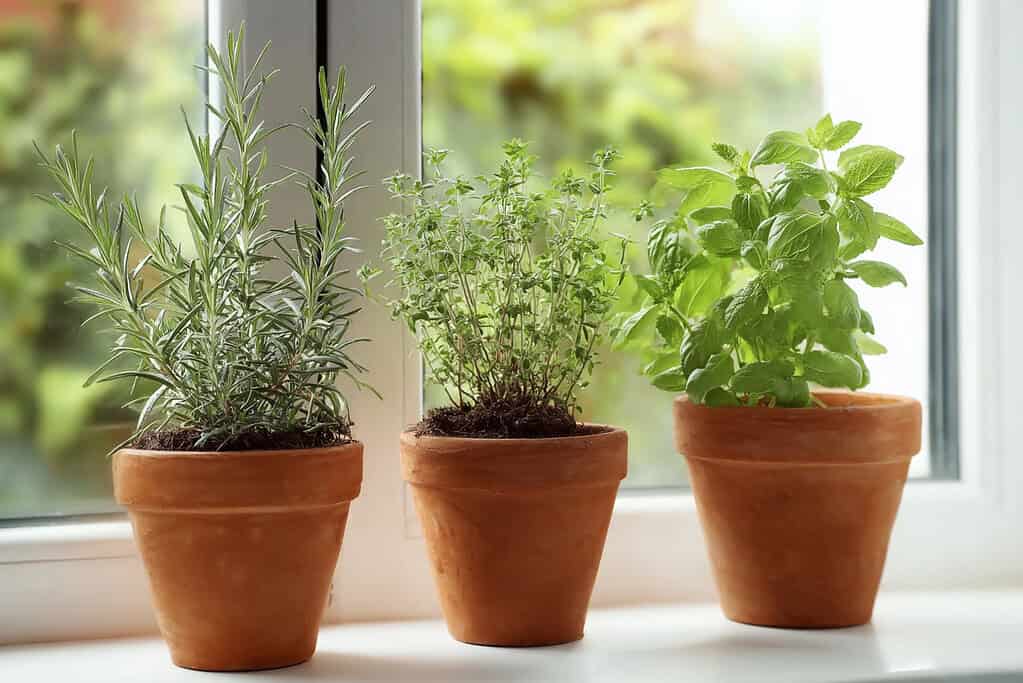
The containers you choose for indoor herbs affect how well they drain, how healthy the roots stay, and how easy the plants are to maintain.
Not all pots are equal when it comes to airflow, moisture control, and safety for edible plants.
Use Containers with Drainage Holes
Drainage is essential. Without proper holes at the bottom of the pot, water builds up in the soil and leads to root rot.
Every container used for herbs should have at least one drainage hole to allow excess water to escape.
For extra protection, place a small tray or saucer underneath each pot to catch any water that drains out.
Best Container Materials for Herbs
Choose containers made from natural, breathable, and food-safe materials.
These options help regulate soil moisture and avoid harmful chemicals:
- Terra cotta: A budget-friendly choice that allows air and moisture to move through the pot walls. This helps prevent overwatering but may dry out faster.
- Cedar or other untreated wood: Natural and attractive, especially for window boxes. Look for untreated or “food-grade” labeling.
- Stainless steel or galvanized metal: Durable and clean-looking. Make sure the container is labeled food-safe and has proper drainage.
Avoid plastic containers that aren’t labeled food-grade, or any pots made with treated materials that could leach chemicals into the soil.
Pick the Right Pot Size and Depth
The size of the container affects both root growth and water retention:
- Small herbs like thyme or chives can grow in shallow pots around 4–6 inches deep.
- Larger herbs like basil, mint, or rosemary need 6–10 inches of depth and enough width to allow spreading.
Using a pot that’s too large can lead to soggy soil, while one that’s too small may limit root growth and require frequent watering.
How to Prevent Water Mess and Soil Leaks Indoors
Indoor herb gardening often means working on kitchen counters, windowsills, or furniture – areas you don’t want stained or damaged by soil and water.
Line Pots to Keep Soil in Place
Watering often causes small bits of soil to leak out through the drainage holes at the bottom of the pot. Over time, this can create dirty trays and clogged surfaces.
To prevent this, line the inside bottom of each pot with a material that allows water to drain while holding soil in:
- Coffee filters – Inexpensive, widely available, and fully compostable.
- Landscape fabric or weed barrier cloth – Durable and reusable options that still allow good drainage.
Place the liner flat at the bottom of the pot before adding soil. This barrier won’t affect plant health but will save you from frequent cleanups.
Use Saucers or Trays Under Each Pot
Always place a saucer or waterproof tray under your pots to catch drainage. Choose trays that are wide enough to cover the base of the pot and deep enough to hold any excess water.
Avoid letting pots sit in standing water long-term. After watering, wait 15–30 minutes and empty any collected water to avoid root rot.
Protect Indoor Surfaces
If you’re placing pots directly on wood, painted, or absorbent surfaces, use a protective mat, rubber tray, or even a plastic cutting board as a barrier.
This protects furniture from moisture rings, mineral stains, and water damage.
Preparing the Best Soil for Indoor Herbs
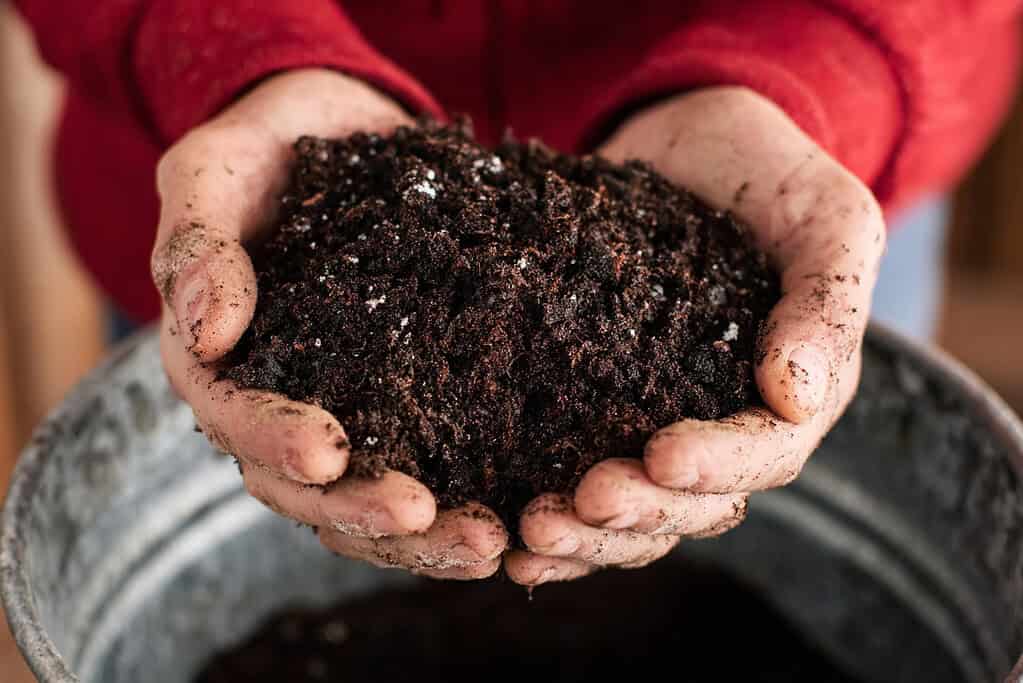
The success of your indoor herb garden depends heavily on soil. Good soil supports root development, drains well, and provides enough nutrients without becoming compacted or soggy.
But not all herbs thrive in the same type of soil – some require dry conditions, while others prefer consistent moisture. Matching the soil to the herb is key.
Don’t Use the Same Soil for Every Herb
Different herbs have different root and moisture needs. Using one soil mix for everything often leads to poor growth or overwatering issues.
- Mediterranean herbs like rosemary, thyme, oregano, and bay laurel prefer loose, fast-draining soil. These plants are prone to root rot in wet or compact soil, especially in cooler temperatures.
- Use a mix of 1 part cactus soil and 1 part regular potting soil. This creates a drier, more breathable base that mimics their native conditions.
- Moisture-loving herbs like basil, parsley, and mint grow best in standard potting soil that retains water well but still drains properly.
Use Organic Compost to Enrich the Soil
To improve nutrient levels, add compost to your mix. One of the best choices for indoor herbs is organic mushroom compost, which feeds the plants slowly without burning the roots.
Adding small amounts of compost also improves the structure of the soil and supports microbial life. Avoid using synthetic fertilizers or heavy composts that may overwhelm small containers.
For a natural, nutrient-rich boost, try composting using the Berkeley method to create your own indoor-friendly compost.
Avoid Peat-Based Mixes When Possible
Many commercial potting soils include peat, but peat is a non-renewable resource and can retain too much water for certain herbs.
Choose peat-free mixes when available, especially if you’re growing herbs that prefer dry soil.
Look for mixes labeled coco-based or ones that include compost and perlite as alternatives.
Keep Soil Additives on Hand for Custom Blends
Having a few basic soil additives gives you flexibility to adjust texture and drainage based on each herb's needs:
- Perlite – Improves drainage and aeration.
- Coco coir – Helps retain moisture without compacting.
- Horticultural sand – Used to loosen dense mixes and add drainage.
These can be mixed in small amounts as needed when repotting or starting new herbs.
How to Plant Indoor Herbs the Right Way
Planting herbs indoors the right way starts with proper tools, the right soil for each herb, and careful handling – especially if you’re separating store-bought plants or starting from seed.
Here’s how to do it correctly from start to finish.
What You’ll Need
- Small trowel or spoon
- Pre-moistened soil (customized per herb type)
- Clean container with drainage holes
- Coffee filter or landscape cloth (to line the pot)
- Seeds or healthy herb seedlings
Step-by-Step: How to Plant Herb Seedlings Indoors
- Line the Container
- Place a coffee filter or piece of weed barrier cloth over the drainage hole to prevent soil from leaking out.
- Add Soil
- Fill the pot about two-thirds full with your customized soil mix.
- Use 50/50 cactus mix and potting soil for herbs like rosemary, oregano, thyme, and bay laurel.
- Use regular organic potting soil for herbs like basil, parsley, and mint.
- Gently press the soil to remove air pockets but don’t compact it.
- Fill the pot about two-thirds full with your customized soil mix.
- Prepare Store-Bought Plants (If Using)
- Remove the plant from its nursery pot. If there are multiple plants jammed into one container, gently tease apart the root balls with your fingers.
- Shake off excess soil and check that each separated plant has its own set of roots.
- Plant the Herb
- Dig a hole in the soil deep enough to fit the roots comfortably.
- Set the plant in and fill around it with more soil, stopping just below the rim of the pot.
- Press the soil gently to hold the plant in place.
- Water Thoroughly
- Water until it begins to drain out the bottom. Wait a few minutes, then pour out any standing water from the saucer.
- Label Each Pot
- If you’re planting more than one herb, especially from seed, label each container to avoid confusion later.
How to Plant Herb Seeds Indoors
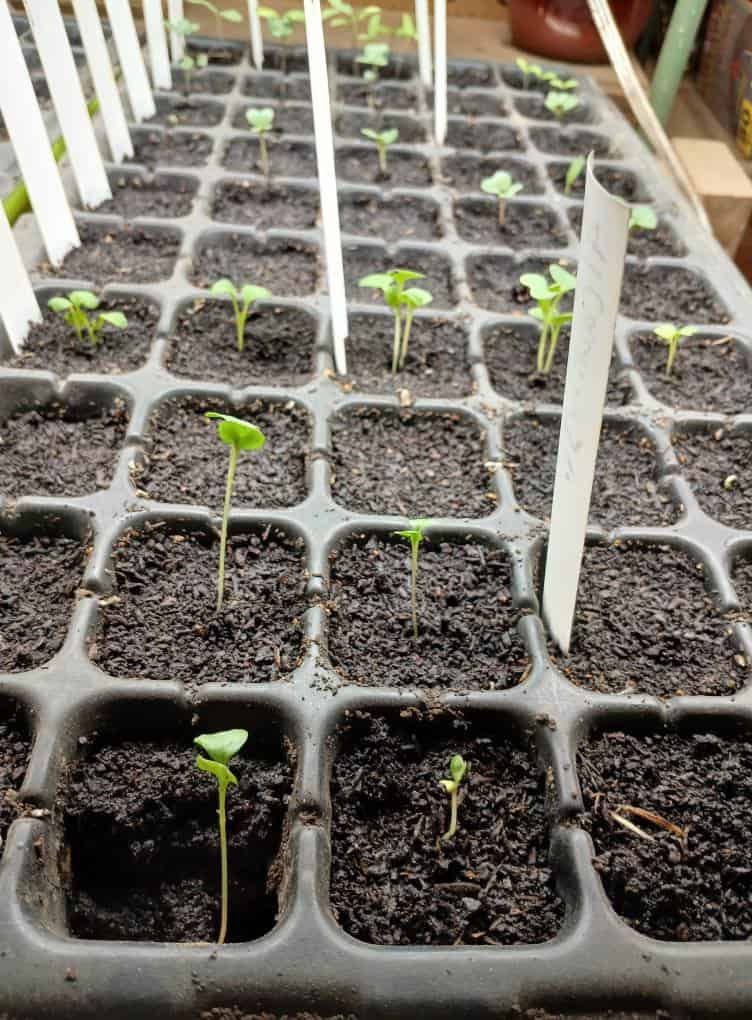
- Fill your pot with a well-draining potting mix, leaving about 1 inch of space below the rim. Moisten the soil lightly so it’s damp but not soggy.
- Plant the seeds according to the packet instructions – most herb seeds should be planted about ¼ inch deep. For very small seeds like basil or thyme, sprinkle them on top and press gently into the soil; there’s no need to cover completely.
- Cover the container loosely with a plastic lid, dome, or clear plastic wrap to retain moisture until the seeds germinate. Ensure some airflow to prevent mold.
- Place the container in a warm, bright spot (65–75°F). If natural light is limited, consider using a grow light to provide 12–14 hours of light per day. Remove the cover once seedlings sprout.
- Thin the seedlings once they develop their second set of true leaves. Remove the weakest plants so only one strong seedling remains per section, allowing it to grow healthy and strong.
Smart Herb Arrangement Tips for Multi-Herb Containers
While it’s often easier to grow herbs in separate pots, you can grow multiple herbs in a single container if you group them carefully.
The key is to match herbs with similar watering, light, and soil needs – and to give each one enough space to grow without crowding or competition.
Group Herbs by Watering Requirements
Herbs differ in how much moisture they need. Mixing moisture-loving herbs with those that prefer drier soil can lead to poor growth or root rot.
- Moisture-loving herbs: Basil, parsley, cilantro
- Dry-soil herbs: Thyme, rosemary, oregano, bay laurel
Only group herbs together if their watering needs align. Otherwise, use individual pots to avoid overwatering or underwatering sensitive varieties.
Isolate Aggressive Growers Like Mint and Lemon Balm
Mint and lemon balm are part of the mint family and spread quickly, both above and below the soil. When grown in shared containers, they tend to dominate and crowd out other herbs.
Always plant these herbs in their own containers, even if their water and light needs are similar to other herbs.
Use the Edges of the Container for Draping Herbs
If you’re using a wide or shallow container for multiple herbs, place trailing or draping herbs like rosemary or marjoram near the edges.
This allows their growth to hang over the sides, making better use of space and improving airflow around other plants.
Leave Enough Space Between Each Herb
Even in a shared container, crowding leads to poor air circulation, increases the risk of pests or mold, and limits each plant’s growth.
Place herbs several inches apart, based on their mature size, and avoid packing too many into one pot.
For those curious about extending these ideas outdoors, check out creative herb garden ideas for inspiration in outdoor spaces.
Natural and Organic Pest Control for Indoor Herbs

Indoor herbs are less likely to face major pest issues than outdoor plants, but problems can still arise especially in warm, humid conditions or when airflow is limited.
Catching issues early and using natural methods can keep your herb garden healthy and chemical-free.
Common Pests in Indoor Herb Gardens
- Fungus gnats – Tiny flying insects that lay eggs in moist soil. Larvae feed on plant roots.
- Aphids – Small green or black bugs that cluster on new growth and suck plant sap (see effective ways to repel aphids naturally)
- Scale insects – Shield-like, immobile pests often found on bay laurel and other woody herbs.
- Spider mites – Nearly invisible; they cause fine webbing and speckled leaves.
Prevent Fungus Gnats with Bottom Watering
Fungus gnats thrive in damp topsoil. To reduce their presence:
- Water from the bottom by placing the pot in a shallow tray of water for 15 minutes.
- Let the soil absorb water from below, then remove the pot and allow it to drain fully.
- Keep the top layer of soil dry between waterings.
Use Neem Oil for Organic Pest Control
Neem oil is safe for edible plants and effective against aphids, spider mites, and scale insects.
How to apply:
- Mix 1 teaspoon of neem oil and a few drops of dish soap into 1 quart of water.
- Pour into a spray bottle.
- Spray directly onto affected leaves – both top and underside.
- Reapply every 7–10 days until pests are gone.
Avoid spraying in direct sunlight to prevent leaf burn. Use in the early morning or evening.
Remove Pests by Hand When Possible
- For aphids, use a damp paper towel to wipe them off, or rinse the plant under a gentle stream of water.
- For scale, use a cotton swab dipped in rubbing alcohol to dab each insect directly.
- Always quarantine new or infected plants away from healthy ones until the issue is resolved.
Improve Air Circulation to Prevent Infestations
Stagnant air and excess humidity create ideal conditions for pests. To reduce the risk:
- Space plants apart to allow airflow.
- Open windows when possible or run a fan on low nearby.
- Avoid overwatering, which attracts many indoor pests.
How to Harvest Herbs for Maximum Growth
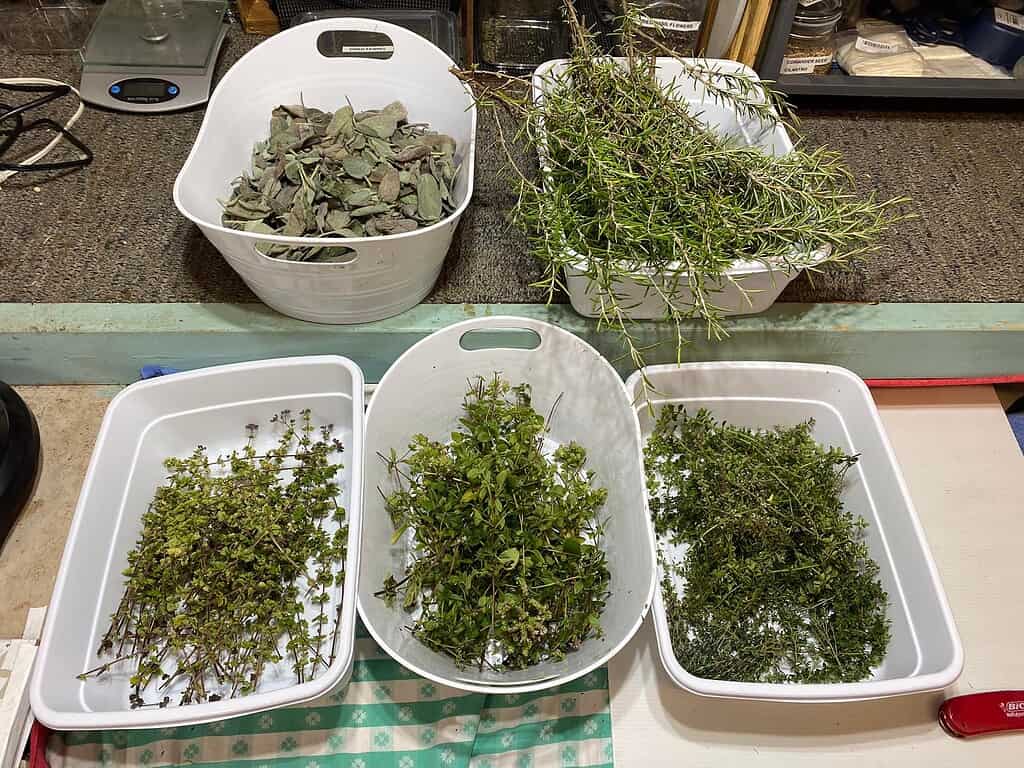
Harvesting herbs the right way encourages the plant to produce more leaves, stay bushy, and live longer.
Cutting too much at once or using the wrong technique can stress the plant and reduce future yields. Here's how to harvest different herbs so they keep growing strong.
Pinch Above a Leaf Node for Bushier Growth
For herbs like basil, oregano, thyme, and mint, always harvest by pinching or snipping the stem just above a leaf node – the point where a pair of leaves grows from the stem.
- Use clean scissors or your fingers.
- Pinch off stems that are at least 4–6 inches long.
- Removing the top growth encourages the plant to branch out and get fuller.
Give Chives a “Crew Cut”
Chives don’t have branching stems, so they’re harvested differently. Use scissors to trim all the leaves down to about 2 inches above the soil.
- This method keeps the plant tidy and prevents it from flopping.
- Leave at least 2 inches so the chives can regrow quickly.
Never Take More Than One-Third at a Time
Avoid harvesting more than one-third of the plant's total growth at once. Taking too much can weaken the plant and slow recovery.
If the herb is still small or newly transplanted, wait until it has enough mature growth before making your first harvest.
Harvest Frequently to Encourage Production
Most herbs grow better when trimmed regularly. Frequent harvesting:
- Prevents the plant from becoming leggy or flowering (which can change the flavor).
- Signals the plant to produce new leaves.
- Helps you get a steady supply of fresh herbs instead of one large harvest.
Harvest in the Morning for Best Flavor
If you’re using herbs right away, cut them in the morning after the dew dries but before the day gets too hot. This is when oils in the leaves are most concentrated, giving the best flavor and aroma.

To preserve your harvest, learn how to dry herbs naturally for long-lasting flavor and use.
Keeping Your Indoor Herbs Healthy and Productive
Once your indoor herb garden is planted and growing, regular care helps keep the plants healthy, full, and producing fresh leaves for months.
Beyond watering and harvesting, herbs need light balance, pruning, and occasional feeding to stay in good condition.
Rotate Plants Regularly for Even Light
If your herbs rely on natural window light, rotate each pot every 2–3 days so all sides of the plant get equal exposure.
Without rotation, herbs often lean or stretch toward the light source, which causes uneven growth and weak stems.
This is especially important for herbs like basil and parsley that grow upright and quickly become lopsided if not turned.
Fertilize Lightly and Only When Needed
Indoor herbs don't need heavy feeding. Too much fertilizer can lead to weak, leggy growth and reduced flavor.
- Use a diluted organic liquid fertilizer (such as fish emulsion or seaweed extract) every 4–6 weeks during active growth.
- Avoid synthetic or slow-release fertilizers not intended for edibles.
If you added compost when planting, skip fertilizing for the first couple of months.
Prune to Prevent Leggy Growth
Herbs like basil, oregano, and mint can become tall and spindly if left unchecked.
- Pinch off the top few inches once the stem reaches 6 inches tall.
- Always cut back to a pair of leaves to encourage branching.
Regular pruning improves shape and makes the plant more productive over time.
Watch for Signs of Stress or Decline
Keep an eye out for early signs of problems:
- Yellow leaves may indicate overwatering or poor drainage.
- Weak or floppy stems often result from low light or overcrowding.
- Stunted growth can be caused by compacted soil or root-bound pots.
Fixing these issues early (whether by adjusting light, watering, or repotting) helps the plant recover quickly and keeps your garden on track.
Planning for Short-Lived Herbs
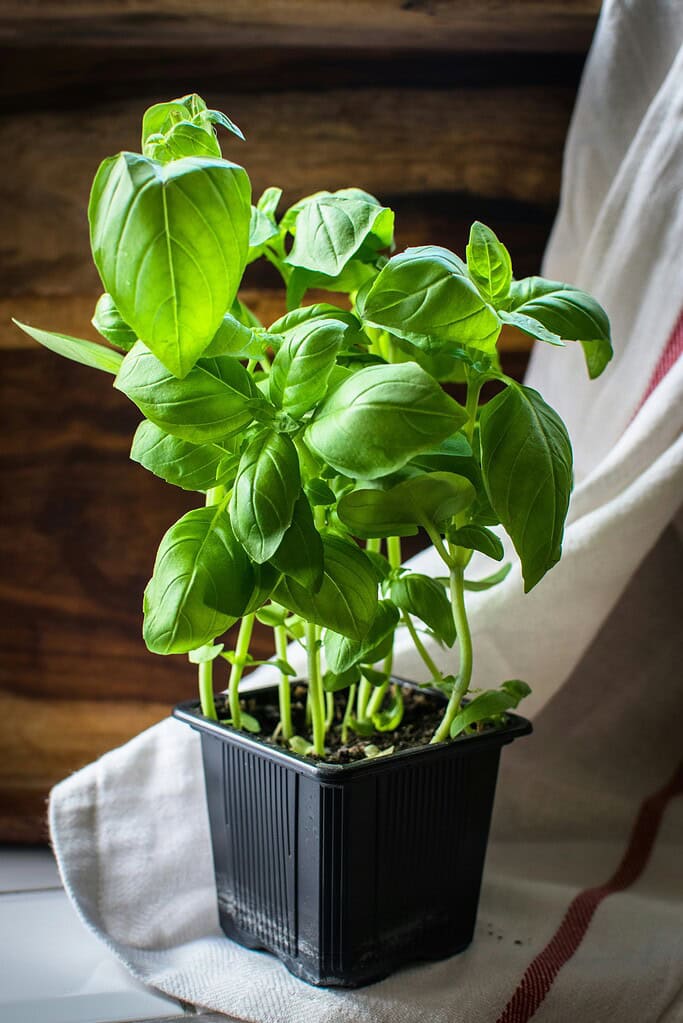
Not all herbs are built to last indoors for months. Some grow quickly, produce well for a short time, then decline – even with proper care.
Understanding which herbs are short-lived and how to rotate them ensures you have a continuous, usable supply without gaps.
Know Which Herbs Are Short-Lived Indoors
Certain herbs naturally have short life cycles or become woody and less productive over time. These include:
- Basil – Becomes woody and less flavorful after a few months.
- Cilantro – Bolts (goes to seed) quickly, especially in warm indoor conditions.
- Chervil – Grows best in cool weather and has a short productive period.
These herbs should be treated as fast, fresh crops, not long-term houseplants.
Succession Planting for a Steady Supply
To avoid running out, start new batches regularly:
- Plant new seeds every 2 to 3 weeks for basil, cilantro, and chervil.
- Use small pots or seed trays to start replacements while older plants are still producing.
- Once the old plant declines, swap it out with a new one that’s ready to harvest.
This approach gives you a steady rotation of fresh herbs without needing to grow everything at once.
Use Compact Containers for Easy Swapping
Short-lived herbs don’t need large containers. Use 4–6 inch pots that are easy to move, replant, or compost when the plant is spent.
Keeping them separate from your long-term herbs makes the rotation smoother.
Troubleshooting Common Indoor Herb Problems
Even with the right setup, problems can still come up in an indoor herb garden. Most issues are easy to fix if caught early.
Here’s how to identify what’s wrong and what to do about it.
Yellowing Leaves
Likely causes:
- Overwatering — Most common reason. Roots are suffocating due to soggy soil.
- Poor drainage — Water collecting at the bottom of the pot or no drainage holes.
- Nutrient deficiency — More common in older plants or those in depleted soil.
What to do:
- Let the soil dry out if it’s wet.
- Check that the pot has a working drainage hole.
- If the plant has been growing for months, add diluted organic fertilizer or top with compost.
Leggy or Floppy Growth
Likely cause:
- Not enough light. Herbs stretch toward the light and weaken when they don’t get enough direct sunlight.
What to do:
- Move the plant closer to a bright window.
- Add a full-spectrum grow light and run it 12–14 hours daily.
- Rotate the pot regularly so all sides get equal light.
Mold or Moss on Soil Surface
Likely causes:
- Overwatering
- Lack of airflow
- Humidity buildup
What to do:
- Reduce watering frequency.
- Scrape off the mold or moss and top the soil with a fresh layer of dry potting mix.
- Improve air circulation – run a small fan or crack a window.
Stunted or Slow Growth
Likely causes:
- Root-bound plant — Roots have outgrown the container.
- Poor soil — Compacted or nutrient-depleted.
- Low light or cold temperatures
What to do:
- Remove the plant from its pot and check the roots. If tightly coiled, repot into a slightly larger container with fresh soil.
- Move the plant to a brighter, warmer location.
Pests That Keep Returning
Likely cause:
- The pests (e.g., aphids, fungus gnats, scale) weren’t fully removed or conditions keep inviting them back.
What to do:
- Reapply neem oil spray every 7–10 days until clear.
- Make sure the top of the soil stays dry between waterings.
- Quarantine infected plants and inspect nearby ones.
Start Small, Stay Consistent, and Grow Fresh Herbs Year-Round
Starting an indoor herb garden doesn’t require a lot of space, money, or experience – just the right containers, soil, light, and attention to each herb’s needs.
From choosing herbs that match your cooking habits to learning how to water, harvest, and troubleshoot, success comes down to setting up the right conditions and staying consistent.
Even if a few plants don’t thrive at first, the learning process is simple and low-cost. You can always replant, adjust, and improve as you go.
Have questions or tips from your own herb gardening experience? Comment down below – we'd love to hear from you.
FAQs
How long does it take for herb seeds to sprout indoors?
Most herb seeds sprout within 7 to 14 days under the right conditions. Basil and cilantro germinate quickly, while parsley can take longer – sometimes up to 21 days. Warmth and moisture speed up the process.
Can I grow herbs in glass jars or cups?
Only if they have proper drainage.
Glass containers without holes can lead to waterlogged soil and root rot. If using jars, add a layer of pebbles at the bottom and water carefully – but proper plant pots with drainage holes are better long-term.
How do I know when to repot my herbs?
Repot if you notice:
- Roots coming out of the drainage holes
- Soil drying out too quickly
- The plant becoming top-heavy or stunted
Choose a pot that’s 1–2 inches wider and refresh the soil during transplanting.
Which herbs grow best with artificial light only?
Chives, mint, parsley, and oregano adapt well to grow lights alone. Make sure the light is full-spectrum and stays on for 12–14 hours a day, placed about 6–12 inches above the plants.
Can I use outdoor garden soil for indoor herbs?
No. Garden soil is too heavy, doesn’t drain well in pots, and may carry pests or disease. Use a high-quality indoor potting mix customized to each herb’s needs, with compost and drainage materials mixed in as needed.
